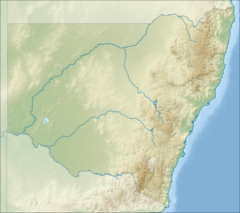South East Forest National Park
| South East Forest National Park | ||
|---|---|---|
| Black Olive Berry (Elaeocarpus holopetalus) on a soft tree fern on Devil's Creek in Tantawangalo in the South East Forest National Park | ||
|
|
||
| Location: | New South Wales , Australia | |
| Specialty: | Eucalyptus Forest, Temperate Rainforest | |
| Surface: | 1,151.77 km² | |
| Founding: | January 1, 1997 | |
The South East Forest National Park is a national park in the extreme southeast of the Australian state of New South Wales , 378 km south of Sydney . There are valuable eucalyptus - primary forests and smaller areas of temperate rainforest .
The park was created in 1997 by merging Genoa National Park , Tantawangalo National Park , Bemboka-Yowaka National Park and Coolangubra National Park . All of these previous national parks were only opened in 1994. The Genoa National Park in turn was the result of the amalgamation of Nalbaugh National Park and Nungatta National Park , which were established in 1972 and 1973, respectively.
Until 1968, most of the southeast corner of New South Wales was wild, virgin forest known as the Wallagaraugh Wilderness , and was considered a free crown land. At that time, a committee appointed by the state government of New South Wales called for an area of approx. 1000 km² to be declared a national park. However, the Japanese company Harris-Daishowa wanted to clear the area for the production of wood chips and most of this land was only declared a state forest. Only the sites in Nalbaugh and Nungatta have been declared national parks. Near the were Mount Imlay National Park and Ben Boyd National Park built.
The logging operation began in October 1969 and, despite increasing protests, continued for 25 years. The Labor government of Barrie Unsworth had promised a national park with an area of 80,000 hectares in 1988 to be re-elected, but the re-election came to nothing. In 1994, under the government of John Fahey, the national parks of Genoa, Tantawangalo, Bemboka Yowaka and Coolangubra were established.
The area is known for a number of species of eucalyptus and hardwood forests cover 42% of the national park. Temperate rainforests are found in sheltered places, on subalpine terrain and high elevations.
Within the limits of the park, a large number of animal species is also endangered species such as the Smoky Australia Mouse ( Pseudomys fumeus ) or shed Kehl thick head ( Pachycephala olivacea ).
Individual evidence
- ^ South East Forest National Park . Government of NSW. Environment & Heritage
- ^ A b South East Forest National Park . Government of NSW. Culture & History
- ^ A b c d Peter Wright: National Parks in Southern NSW . Bridge Printery. Rosebury NSW (1996). ISBN 0-958759-01-4 . P. 235
- ^ Clover Moore: South East Forests Protection Bill . Parliament of New South Wales: Hansard and Papers. Sydney (September 3, 1992)
- ^ A b South East Forest National Park: Native Vegetation . Office of Environment & Heritage. NSW Government
- ^ South East Forest National Park: Native Animals . Office of Environment & Heritage. NSW Government

